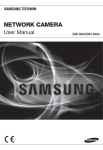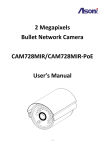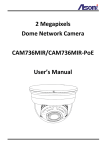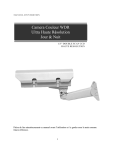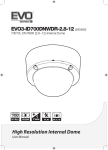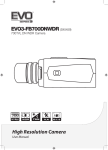Download Velleman DVR-4LCD User manual
Transcript
VIDEO VIEWER USER MANUAL Please read instructions thoroughly before operation and retain it for future reference. Video_viewer_V1.0 LEGAL INFORMATION Reproduction, transfer, distribution or storage of part or all of the contents in this document in any form without the prior written permission of the company is prohibited. Microsoft, Windows and the Windows® logo are either registered trademarks or trademarks of Microsoft Corporation registered in the United States and/or other countries. Product and company names appearing in this document are trademarks of each respective company or organization. Under no circumstances shall we be responsible for any loss of data or income or any special, incidental, consequential or indirect damages howsoever caused. The contents of this document are provided “as is”. Except as required by the applicable law, no warranties of any kind, either express or implied, including, but not limited to, the implied warranties of merchantability and fitness for a particular purpose, are made in relation to the accuracy, reliability or contents of this document. All the pictures in this manual may vary from the actual ones you see because different device may have its own setting pages. We reserve the right to revise this document or remove it at any time without prior notice. MPEG4 Licensing THIS PRODUCT IS LICENSED UNDER THE MPEG-4 VISUAL PATENT PORTFOLIO LICENSE FOR THE PERSONAL AND NON-COMMERCIAL USE OF A CONSUMER FOR (i) ENCODING VIDEO IN COMPLIANCE WITH THE MPEG-4 VISUAL STANDARD (“MPEG-4 VIDEO”) AND/OR (ii) DECODING MPEG-4 VIDEO THAT WAS ENCODED BY A CONSUMER ENGAGED IN A PERSONAL AND NON-COMMERCIAL ACTIVITY AND/OR WAS OBTAINED FROM A VIDEO PROVIDER LICENSED BY MPEG LA TO PROVIDE MPEG-4 VIDEO. NO LICENSE IS GRANTED OR SHALL BE IMPLIED FOR ANY OTHER USE. ADDITIONAL INFORMATION INCLUDING THAT RELATING TO PROMOTIONAL INTERNAL AND COMMERCIAL USES AND LICENSING MAY BE OBTAINED FROM MPEG LA, LLC. SEE HTTP://WWW.MPEGLA.COM. Version: 0206 TABLE OF CONTENTS 1. OVERVIEW .................................................................................................................................................... 1 1.1 Product Features .......................................................................................................................................................................1 1.2 Prerequisites ..............................................................................................................................................................................1 2. CONTROL PANEL OVERVIEW...................................................................................................................... 2 2.1 Accessing the device .................................................................................................................................................................2 2.2 Control panel overview ..............................................................................................................................................................2 2.2.1 Simplified Version (Default) .............................................................................................................................................................. 2 2.2.2 Full Function Version ........................................................................................................................................................................ 3 2.2.3 Main Button Overview ...................................................................................................................................................................... 3 3 FREQUENTLY-USED FUNCTIONS ................................................................................................................ 5 3.1 Record .......................................................................................................................................................................................5 3.2 Playback ....................................................................................................................................................................................6 3.2.1 Playback Panel................................................................................................................................................................................. 6 3.3 Full Screen Display....................................................................................................................................................................7 3.4 Live Audio Volume Adjustment ..................................................................................................................................................7 3.5 Network Backup.........................................................................................................................................................................8 3.6 Firmware / OSD / Logo Upgrade ...............................................................................................................................................9 3.7 E-Map ......................................................................................................................................................................................10 4. ADDRESS BOOK ......................................................................................................................................... 15 4.1 Overview ..................................................................................................................................................................................15 4.2 Configuration Page for Device Access ....................................................................................................................................16 5. RECORD ...................................................................................................................................................... 17 5.1 Overview ..................................................................................................................................................................................17 5.2 Record Time Range.................................................................................................................................................................18 5.2.1 Weekly............................................................................................................................................................................................ 18 5.2.2 Custom ........................................................................................................................................................................................... 18 5.3 Record Path .............................................................................................................................................................................19 6. CUSTOM SETTING...................................................................................................................................... 20 6.1 Overview ..................................................................................................................................................................................20 6.1.1 General........................................................................................................................................................................................... 20 6.1.2 Connection ..................................................................................................................................................................................... 20 6.1.3 Live................................................................................................................................................................................................. 21 7. STATUS LIST ............................................................................................................................................... 22 7.1 Overview ..................................................................................................................................................................................22 7.2 Log Searching..........................................................................................................................................................................22 7.2.1 Time Range .................................................................................................................................................................................... 22 7.2.2 Record Type ................................................................................................................................................................................... 23 7.2.3 Log List ........................................................................................................................................................................................... 23 8. DVR / PTZ CONTROL.................................................................................................................................. 24 8.1 DVR Control Panel ..................................................................................................................................................................24 8.2 PTZ Control..............................................................................................................................................................................26 APPENDIX 1 SPECIFICATIONS ...................................................................................................................... 27 1. OVERVIEW Video Viewer, the free Central Management System (CMS) software, offers a powerful and integrated solution for centrally managing and monitoring. Compatible with Windows 8, Windows 7, Windows Vista and Windows XP, each CMS server can manage up to 16 devices simultaneously. The friendly graphical interface with full functions for the advanced management, intelligent motion detection, flexible scheduled recording and quick event search makes Video Viewer excellent for every security demand. Furthermore, EMAP is also supported for quick and convenient multi-site surveillance. 1.1 Product Features Multi-site surveillance and full central management software running on Windows 8, Windows 7, Windows Vista and Windows XP Allows multiplex operations (live view, record, playback, backup and network) equipped with intelligent motion detection function Google map connection for EMAP application Pre- and post-event recording to capture full evidence Full record log and graphical design for quick event search PTZ camera control 1.2 Prerequisites Before using Video Viewer, make sure: 1) You have installed the software from the supplied CD, or it could be downloaded from here. Note: If you’re unable to install this software, please log into Windows with an administrator account, and try again. 2) The computer on which Video Viewer is installed is connected to Internet. 3) The device (DVR, NVR and / or IP camera) you’re intended to connect is configured well to connect to Internet, and you know the IP address, port number, user name and password to access it. To know how to configure your DVR and NVR to the Internet, please see here; to know how to configure your IP camera to the Internet, please see here. To know how to use this software, please refer to “2. CONTROL PANEL OVERVIEW” at page 2. 1 2. CONTROL PANEL OVERVIEW 2.1 Accessing the device Step1: Double-click “ ” on your PC desktop to open Video Viewer. By defaults, the “Address Book” panel will be displayed on the right side of the control panel. Step2: Click “ ” to select the IP address of the device you intend to connect, and double-click it. Step3: The live view is displayed in the Video Viewer. 2.2 Control panel overview Two control panels are available and can be switched depending on your using habit. 2.2.1 Simplified Version (Default) 2 2.2.2 Full Function Version 2.2.3 Main Button Overview Button Simplified Full Function Function Address Book Description Click to show the predefined IP address(es). You can add, remove or search the IP address to log in the DVR remotely. For details, please refer to “4. ADDRESS BOOK” at page 15. Miscellaneous Control Log Remote Config Click to go to the detailed system configuration. Record Setting Click to go to the record setting page for all connected devices. For details, please refer to “3.1 Record” at page 5. Custom Setting Click to choose the language of this program. The language change will take effect when this program is closed and executed again. Click to view all event and recording logs, search the desired log(s) by date, or playback the recording of the selected log. For details, please refer to “7. STATUS LIST” at page 22. Click to start / stop manual recording for all connected devices. / / Record / Record Stop Snapshot Information To enable / disable the manual recording function for a single device, please refer to “4. ADDRESS BOOK” at page 15. The record button will be disabled when the reserved disk capacity set in “Record Setting” is larger than the current disk capacity. For details, please refer to “3.1 Record” at page 5. Click to take a snapshot for the current view. The snapshot pictures will be saved in the path you specified in “Record Setting”. For details, please refer to “3.1 Record” at page 5. Click to show the current network connection details. 3 Button Simplified Full Function Function Description DVR Control Click to open the DVR control panel for remote control. For details, please refer to “8.1 DVR Control Panel” at page 24. PTZ Control Click to open the PTZ control panel to control the PTZ camera. For details, please refer to “8.2 PTZ Control" at page 26. Backup Click to download and backup event footage saved in the DVR / NVR hard disk(s). 4 3 FREQUENTLY-USED FUNCTIONS 3.1 Record To record remotely, click “ ” (simplified version) or “ ” (full function version) → “ ” to go to the “Record Setting” page. For details, please refer to “5. RECORD” at page 17. In the “Record Setting” page, you can set the following items: ‧Record type ‧Pre- / post-event record ‧Record time setting ‧Record path Note: The record function will be disabled when the reserved disk capacity in “Reserved(MB)” is larger than the current disk capacity in “Free(MB)”. When “Manual” is checked, click “ ” (simplified version) or “ ” (full function version) on the main control panel to start manual recording immediately, and all recordings will be saved in the location specified in “Record Path”. When “Motion” and / or “Alarm” are checked, the recording function will be enabled for a motion or alarm event, and all recordings will be saved in the location specified in “Record Path”. 5 3.2 Playback To play a recording, click “ ” (simplified version) or “ ” (full function version), and select the “Record” tab. A list of all recordings will be shown by defaults, and you can also sort out the logs you want to speed up the search time. For details, please refer to “7. STATUS LIST” at page 22. 3.2.1 Playback Panel Simplified Version Full Function Version Button Simplified -- Full Function -- Function Description Play Click to play the selected video clip. Pause Click to pause the video playback. Stop Click to stop the video playback. Rewind Click once to get 2X fast rewind, twice to get 4X, three times to get 8X, and four times to get 16X the highest. Forward Click once to get 2X fast forward, twice to get 4X, three times to get 8X, and four times to get 16X the highest. De-Interlace Select to reduce the vibration of the paused picture. 6 3.3 Full Screen Display Click (simplified version) or (traditional version) to display images in the full screen mode. To quickly control each device without returning to the original mode, right-click to display the translucent quick menu bar similar as follows: Button / / / / Function Description Return to normal display Click to return to the simplified version display or full function version display. Device Display Mode Click to select the device display mode depending on how many devices you’re connected. DVR Control (When the selected device is a DVR) Click to show the DVR control panel. For details about each button, please refer to “8.1 DVR Control Panel” at page 24. PTZ Camera Control (When the selected device is a PTZ camera) Click to show the PTZ camera control panel. For details about each button, please refer to “8.2 PTZ Control” at page 26. / 3.4 Live Audio Volume Adjustment Click and drag the slider live audio volume. (simplified version) or (full function version) to adjust the To mute the audio, click the speaker icon once to disable audio transmission; to restore the audio, click the icon again. To hear the live audio from other audio channel(s) of the selected device when the selected device connects to more than one audio camera, please refer to “8.1 DVR Control Panel” at page 24. This function is available only when: The selected device supports the audio function. For details, please refer to the user manual of the selected device. “Video/Audio” is selected in the configuration page. For details, please refer to “4.2 Configuration Page for Device Access” at page 16. 7 3.5 Network Backup Click “ ” (simplified version) or “ ” (full function version), and select IP address of the DVR you want to make video backup in the address book. Then, click “ ” (simplified version) or “ ” (full function version) to go into the “Backup” page, and you can select a specific time range or event to make a video backup remotely. Note: You need to be a supervisor to operate this function. Function Description HDD Number / Channel Specify the hard disk (HDD Number) and channel number (Channel) within which have the video data you need. List Search by Time Specify the time range within which has the video data you want in the “Start Time” and “End Time” columns. Search by Event Select an event log from the event list. This list shows all logs in the specified DVR from the latest to the earliest. ‧To quickly find the events you need, check or uncheck the event type(s), and select the log you want. ‧To view the earlier or later logs that are not shown in the current page, click “Prev. Page” or “Next Page”. ‧To refresh the event list, click “Reload”. Calendar Search by Calendar Directly choose the date and time from the calendar, and download. The date and time with recorded data will be especially marked. File Path Assign the location where the backup files are saved. File Size Limit the maximum file size downloaded. If the footage selected is larger than the specified file size, a second file will be generated, and so on. Simultaneous Playback To view the backup images simultaneously when the download process is in progress, select “Simultaneous Playback”. You will see the backup images while the images are being downloaded to the PC or notebook. To simply backup images without previewing, deselect “Simultaneous Playback”. You will only see a message box indicating the total time needed, the current status and the saving location. Download / Cancel Click “Download” to start or “Cancel” to discard the video backup. 8 3.6 Firmware / OSD / Logo Upgrade This function is used when users need to upgrade the selected device for function scalability. The available upgrade items may vary based on the device connected. Note: Before using this function, make sure you have the correct upgrade files provided by your installer or distributor. Step1: Click “ ” (simplified version) or “ ” (full function version), and select the IP address of your device in the address book. Step2: Click “ ” (simplified version) or “ ” (full function version) to show the upgrade page, “Update Server”. Step3: Select the items you want to upgrade, and click “Add” to browse to the upgrade files. Step4: Click “Upgrade Firmware” / “Upgrade OSD / “Upgrade Logo” to start upgrading. Note: It takes a few minutes to finish the upgrade process. Do not disconnect the power during firmware upgrade, or the upgrade may be failed. The selected device will reboot after the upgrade. Note: “Upgrade Logo” is a function to change the DVR welcome logo, and the acceptable graphic file format is BMP. Use the image software (such as Photoshop) to set the image size to 360 * 240 pixels, save the image as an 8-bit (64-color) image in the "BMP" format, and make sure the file size is not more than 128KB. Step5: The selected device will reboot when the upgrade is successful. Wait till the device is rebooted and check if the upgrade is really successful: Firmware: Click (full function version) (simplified version) or to enter the system configuration page, and select “General” to check whether the firmware version is upgraded. Language: Click (simplified version) or (full function version) to open the DVR control panel, and enter the DVR menu to select the language. For details, please refer to the user manual of your DVR. Logo: When the DVR is rebooted, check if the welcome logo is replaced during the initialization stage. 9 3.7 E-Map Note: Before using this function, make sure Video Viewer is connected to all the devices (up to 16) you want to monitor. E-Map is ONLY available when the control panel is switch to the full screen version (full function version). How to Add an E-Map Group STEP1: In the simplified version, click “ click “ ” to switch the control panel to the full function version, and ” to enter the E-Map page as follows. Note: To know where the buttons are, please refer to “2.2.1 Simplified Version (Default) at page 2, and “2.2.2 Full Function Version” at page 3. 10 STEP2: Right-click to show the shortcut menu on the top-left panel, and select the E-Map group you want to add. There are three E-Map groups you can add: Google E-MAP, Single E-MAP, and Building E-MAP. 11 STEP3: When the E-Map group is created, you will see the tree on the top-left panel, showing all the devices you’ve added to this group. Icon Description The connected device is camera. When it’s selected, it will become red. The connected device is DVR. When it’s selected, it will become red. For any motion or alarm event, it will appear on the screen to catch your attention. To know what’s happening quickly, double-click the device icon on the E-Map to show the live view. 12 How to Edit / Remove an Existing E-Map Group For Google E-Map Group Right-click on the group name to show the shortcut menu list, and select “Edit E-MAP” or “Remove E-MAP” as needed. You can also add a single E-Map group (Add Single E-MAP) or Building E-Map group (Add Building E-MAP) into the existing Google E-Map group. For Single E-Map Group Right-click on the group name to show the shortcut menu list, and select “Edit E-MAP” or “Remove E-MAP” as needed. 13 For Building E-Map Group Right-click on the group name to show the shortcut menu list, and select “Edit Building E-MAP” or “Remove E-MAP” as needed. 14 4. ADDRESS BOOK 4.1 Overview Simplified Version Full Function Version Button Simplified Full Function Function Description Address Book Click to enter the address book panel. Address Book Click to directly add one IP address for login. Key in the access information needed, and click “Apply” and “Close”. Add For details about the configuration page, please refer to “4.2 Configuration Page for Device Access” at page 16. Select one current IP address from the address list, and click this button to modify the access information as needed. Edit For details about the configuration page, please refer to “4.2 Configuration Page for Device Access” at page 16. Export Click to export the address book in an xml file. Import Click to import the address book in XML to Video Viewer. Remove Select one IP address from the address list, and click this button to delete it. Backup Click to enter the “Backup” page for DVR video backup. For details, please refer to “3.4 Live Audio Volume Adjustment” at page 7. Update Server Click to update the firmware / OSD / logo of the selected device. For details, please refer to “3.6 Firmware / OSD / Logo Upgrade’ at page 9. Check “REC” to enable manual recording of the selected device. REC REC Manual Record On 15 To manage manual recording for all connected devices, please refer to “5. RECORD” at page 17. Button Simplified Full Function E.T. E.T. Function Description Event Trigger Check “E.T.” to enable event trigger recording Search Click to enter the search panel for available device searching. Add into address book Select one device from the available IP address list, and click this button to add the selected address to the address book. Setting Select one device from the available IP address list, and click this button to change the current IP configuration of the selected device if needed. Refresh Click to update the available IP address list. Search 4.2 Configuration Page for Device Access This page should contain the correct information for accessing your device remotely. Function Description Apply / Login Click “Apply” to save the setting and return to “Address Book” panel, or click “Login” to save the setting and directly log into the device immediately. Cancel Click “Cancel” to discard the setting. General Method Select “TCP” or “UDP” based on your connection situation. IP Address / Port / User name / Password Enter the IP address / port number / user name / password for accessing the device you want. Get Type Click “Get Type” for this software to identify the type of your device, and make sure the corresponding functions available for the device will operate normally in this software. Format / Resolution Select the codec “MPEG4”, “JPEG”, “H264” or “Default” for streaming, and the resolution you need. The available options may vary based on the device you want to access. Note: This function is valid only for IP cameras. Select “Video/Audio” or “Video” to ensure whether the web audio transmission is needed. Av Option Channel When your device supports web audio transmission but “Video” is selected, no audio is transmitted. When your device doesn’t support web audio transmission but “Video/Audio” is selected, no audio is transmitted. Select “Multi-Channel” to see all video channels on your recorder, or “Single-Channel” to select only one channel on your recorder. Note: This function is valid only for recorders (DVR / NVR). Comment (Optional) Enter a description for this device. Advanced Event Sound / Event Sound Duration Check “Event Sound” to enable the event alert sound, and it’s available to change the default alert sound. Then, select how long the alert sound will last (3 ~ 60 seconds) in “Event Sound Duration”. 16 5. RECORD 5.1 Overview To manage remote recording for all connected devices, click “ function version) → “ ” (simplified version) or “ ” (full ” to go to the “Record Setting” page. The settings here will apply to all connected devices, and all recordings will save in the location specified in “Record Path”. Note: It’s recommended to specify the record path to the hard disk other than the boot hard disk to protect your recording data. Function Description Check to enable Manual / Schedule / Motion / Alarm recording. For manual recording, the recording starts when “REC” is selected in “Address Book”, and or is selected in the main control panel. For details, please refer to “4.1 Overview” at page 15, and “2.2 Control panel overview” at page 2. Record On/Off For schedule recording, the recording starts during the time specified in “Record Time Range”. For motion & alarm recording, the recording starts when the connected device has detected motion or alarm events during the time specified in “Record Time Range”. Prev/Post Event Record Check to enable pre-alarm recording / post-alarm recording before (Prev.) / after (Post) a motion or alarm event. This function helps to capture full evidences for a motion or alarm event. Overwrite Hard Disk Check this option, and the hard disk will start to overwrite from the oldest data when the available capacity of the specified record path is full. Record Time Range Set the record time for schedule, alarm or motion recording by week or by time. For details, please refer to “5.2 Record Time Range” at page 18. Record Path Select the hard disk in which you want to save all recordings and snapshots. For details, please refer to “5.3 Record Path” at page 19. 17 5.2 Record Time Range 5.2.1 Weekly Click “Weekly” tab, and you will see a weekly time table indicating the week days (Mon ~ Sun) and hours (0 ~ 24), similar to the figure below: X axis: 0 ~ 24 hours. Each time interval within a square is 15 minutes. Y axis: Monday ~ Sunday. Operation: You can set the record schedule for 3 record types as needed in this time table: The 1st timeline – Schedule l recording, indicated in yellow, The 2nd timeline -- Alarm recording, indicated in magenta, and The 3rd timeline -- Motion recording, indicated in cyan. Click and hold the start time point, and drag to the end time point to set the record time range. 5.2.2 Custom Click “Custom” tab, and you can set a more specific record time range for the 3 record types: Schedule, Motion, and Alarm. How to add a new time setting Step1: Check the record type you want to schedule the recording. Step2: Set the start time (From) and end time (To). Step3: Click “Add” to add the time range you just set into the schedule table. Before adding the time range, you will be prompted to confirm as follow: Step4: Check if the information shown is correct. Click “OK” if the information is correct. Click “Cancel” if the information is wrong. How to modify / delete a current time setting Step1: Select the schedule setting you want to modify from the schedule table. The setting will be displayed in the left panel. Step2: To modify the setting, click “Update”; to delete the setting, click “Delete”. Step3: If the setting is modified, you will be prompted to confirm the setting. Click “OK” if the information is correct. Click “Cancel” if the information is wrong. 18 5.3 Record Path Check and select the location for saving all recordings and snapshot pictures. Function Description Drive It lists all the hard disks in your PC. Select the hard disk in which you want to save all recordings and snapshot pictures. It’s recommended to save them to the hard disk other than the boot hard disk to protect your recording data. Total(MB) It shows the total capacity of the hard disk. Free(MB) It shows the remaining capacity of the hard disk. Reserve(MB) It shows the minimum reserved disk capacity for saving all recordings and snapshot pictures. This value can be changed based on your current situation. To change the value, click and modify as needed. The record function will be disabled when the reserved disk capacity in “Reserve(MB)” is larger than the current disk capacity in “Free(MB)”. Video Path It shows the location where all recordings are saved. To change the location, click it twice and browse to the location you want. Picture Path It shows the location where all snapshot pictures are saved. To change the location, click it twice and browse to the location you want. 19 6. CUSTOM SETTING To manage remote recording for all connected devices, click “ function version) → “ ” (simplified version) or “ ” (full ” to go to the “Record Setting” page. The settings here will apply to all connected devices, and all recordings will save in the location specified in “Record Path”. Note: It’s recommended to specify the record path to the hard disk other than the boot hard disk to protect your recording data. 6.1 Overview Click “ ” (simplified version) or “ ” (full function version) → “ ” to go to the “Custom Setting” page. There are three tabs to allow you make different preferences. 6.1.1 General In this tab, users could: Choose the UI language from English, Chinese, French, German, Portuguese, Spanish and Japanese. Choose if Video Viewer should start automatically after Windows starts. Ask Video Viewer to remember the last status before it’s closed, and restore to the last status when it’s activated again. Ask Video Viewer to prompt password check when it’s activated. 6.1.2 Connection In this tab, users could configure the selected device in the address book to use Proxy server for connection if needed to enhance its access speed, and enter its address and port used. Note: This function is available only when the selected device is disconnected. 20 6.1.3 Live In this tab, users could configure the duration in seconds for: Full sequence in the live mode when is selected in (simplified version), or is selected in (full function version). Quad sequence in the live mode when is selected in (full function version). Note: This function is available only for DVR / NVR. 21 (simplified version), or is selected in 7. STATUS LIST 7.1 Overview Click “ ” to check all logs, or search for specific log(s) by date and / or record type for all devices. There are three log types: Record, Backup and Event. To playback a video clip for a specific record or backup log, select the log, and double-click it to start video playback. Function Description Time Range Select the time range for log searching. For details, please refer to “7.2.1 Time Range” at page 22. Record Type Select the specific record type(s) for log searching. This section is available only in the “Record” list. For details, please refer to “7.2.2 Record Type” at page 23. Record / Backup / Event / Event Trigger It lists all the record / backup / event / event trigger logs or the specified logs after log searching. For details, please refer to “7.2.3 Log List” at page 23. Query Click to refresh the current log list after the searching criteria are set. 7.2 Log Searching To quickly search the logs you want in the current log list, you need to set the criteria first by time and / or record type. 7.2.1 Time Range Function Description Range Unit Select the time search range by “One Week” or “One Day”. Start Time Set the start time for time search. The end time will automatically switch to the date after one week or one day from the start time based on your selection in “Range Unit”. 22 7.2.2 Record Type There are four record types: User / Motion / Alarm / RETR. Check the record type you want to search. Note: This section is available only when the “Record” tab is selected. Function Description User Check this and all logs for manual recording will show. The log is generated when this function is enabled in “Address Book”, and or is selected in the main control panel. Motion Check this and all logs for motion recording will show. The log is generated When the connected device has detected a motion event during the time specified in “Record Setting”. Alarm Check this and all logs for motion recording will show. The log is generated When the connected device supports the alarm function and has detected an alarm event during the time specified in “Record Setting”. RETR Check this and all logs for RETR recording will show. The log is generated when the connected device supports the R.E.T.R. function and this function is enabled in “8.1 DVR Control Panel”. 7.2.3 Log List There are three log lists: Record, Backup, Event & Event Trigger. By defaults, the log lists show all the logs. To quickly search the logs you want, you can narrow down the list by time and / or record type. Function Description Reserve Select the log which is considered important and can’t be removed, and click it to prevent accidental removal. Play Click it to know what’s recorded for the selected log. Repair Select the log with “Error” checked, and click it to try to fix the file. Delete / Delete All Select a specific log you don’t need or all logs, and click “Delete” or “Delete All” to remove. The log with “Reserve” checked will not be removed even when it’s selected to be removed. 23 8. DVR / PTZ CONTROL 8.1 DVR Control Panel When the selected device is a DVR, click or to show the DVR control panel for remote control. For the function of each button, please refer to the following description. Note: The control panel below is taking a 16CH DVR model as an example and for reference only. Some buttons may not be enabled or appeared for selected models. Function Button Simplified Description Full Function Remote Independent Mode Click to activate / deactivate the network independent function. When this function is on, this button and the channel number buttons will turn to blue, and you can switch to any channel of the selected device you want to see without changing the channel display mode on the local site. To exit the remote independent mode, click this button again. Channel 1~16 / 1~8 / 1~4 1~16 / 1~8 / 1~4 Click the channel number to switch to the live view of the selected channel. Number Enter Click to confirm the setting or enter your selection. Menu Click to enter the DVR OSD menu. Arrow Keys Click to: / / / / / / 1. Move the highlight up / down / left / right. 2. Make selection. Event Search Click to get access to the time & event search mode of the selected device. R.E.T.R Click to activate the R.E.T.R. function. Audio Channel Selection / Click to switch to the audio channel you want. The selected channel is shown as green. / To know whether your device supports the audio function, please refer to the user manual of your device. To adjust the live audio volume, please refer to “4.4 Live Audio Volume Adjustment” at page 7. R.E.T.R. Audio / When the R.E.T.R. function is selected and activated, the R.E.T.R. / audio function will be on, too. If you don’t want to activate this function, click the red icon again to disable this function. Video Channel Selection Click to display CH1, CH2, CH5 and CH6. Click to display CH3, CH4, CH7 and CH8. Click to display CH9, CH10, CH13 and CH14. Click to display CH11, CH12, CH15 and CH16. 24 Function Button Simplified Description Full Function Click to display the 1st channel of the selected 4-cut view mode. Click to display the 2nd channel of the selected 4-cut view mode. Click to display the 3rd channel of the selected 4-cut view mode. Click to display the 4th channel of the selected 4-cut view mode. / / / / Click to switch to the 4-cut / 9-cut / 16-cut display. / You can also click these two buttons to go to the previous / next channel of the selected device. / Digital Zoom Press to zoom in / out the selected channel image. Full Sequence Press to display each channel of the selected device one by one, starting from CH1. When the last channel is displayed, it will start from CH1 again. To exit from this display mode, press any channel display mode. Quad Sequence Quad Sequence Click to display the 4 quad display modes one by one. The 1st display is CH1, CH2, CH5 & CH6, the 2nd display is CH3, CH4, CH7 & CH8, the 3rd display is CH9, CH10, CH13 & CH14, and the 4th display is CH11, CH12, CH15 & CH16. When the 4th display is shown, it will start from the 1st display again. To exit from this display mode, click any other channel display button. Search Press to enter the full search menu of the selected device. You can check all the logs here, and select one of them to payback. Key Lock Click to enable the key lock function for the selected device. To unlock the device, key in the password, and press or . Playback Operation Play Press to play the latest recorded video clip. Stop Press to stop the video playback. Pause Press to pause the video playback. Click to forward the video playback. Forward Click once to speed up the forward by 4 times, and press twice by 8 times, etc. The maximum speed is 32 times. Click to rewind the video playback. Rewind Click once to speed up the rewind by 4 times, and press twice by 8 times, etc. The maximum speed is 32 times. Click once to slow down the video playback by 1/4 time, and press twice by 1/8 time. Slow Click to open the event search page for video backup. For details, Backup please refer to the description of -- Overview” at page 3. 25 in “2.2.3 Main Button 8.2 PTZ Control Note: This function is available only when the selected device is a camera, and the camera has its own OSD menu or function control, such as a speed dome camera or motorized camera. Note: Some buttons may not be enabled or appeared for selected models. Click or Function Preset 1~16 to display the PTZ control panel as follows. Button Simplified Full Function 1~16 1~16 Description Click to move the PTZ camera to the selected preset point. Click to activate the auto function. Before using it, you need to assign a specific function that will be enabled when “AUTO” is clicked. For details, please refer to the user manual of the PTZ camera. Auto Pan Auto Tracking Click to activate the auto tracking function if the connected PTZ camera supports it and have set the surveillance area. Auto Move Click to enable the auto move function. It allows the camera to move to the direction where your cursor stays. IR Control Click to activate the IR function manually. Zoom In / Out / / Click to zoom in / out the image. Max Zoom In / Out / / Click to zoom in the image to the largest / zoom out the image to its original size. Smart Zoom Click to enable the Smart Zoom function to zoom in on the object which triggers motion or alarm recording automatically. Smart Zoom 10 Click to enable the Smart Zoom function to get 10X zoom in on the object which triggers motion or alarm recording automatically. DPTZ Click to enable digital PTZ functions with zoom-in ratio up to 16X. Focus Near / Far / Click to adjust the focus of the image. / Manual Alarm Out Click to force your alarm-out device to work. For example, when your alarm device is a buzzer, click this button and your buzzer will start to sound even if there’s no alarm event. Arrow Keys Click to: 1. Move the camera lens up / up-left / down / up-right / left / down-right / right / down-left. 2. Make selection. -- -- Speed up the menu selection from 1 to 10. Ex: If the value of the turbo step is set to 5, one mouse-click will function as 5 mouse-clicks when you click the arrow keys. Turbo Step To use this function, you need to set it in the camera configuration page first. 26 APPENDIX 1 SPECIFICATIONS ▓ SYSTEM REQUIREMENTS Operation System Microsoft Windows 8, Windows 7, Windows Vista and Windows XP, CPU Intel core i3 or higher, or equivalent AMD RAM 2GB RAM or above ▓ CENTRAL MONITORING Display Mode 1CH / 4CH / 6CH / 9CH / 16CH Selectable Display Mode Setting Adjustable Sequence & Channel Display Position Max. Channel No. 16 Remote DVR/PTZ Camera Control YES Real-Time Audio Monitoring YES Security Level Guest / Normal / Power User / Supervisor Password Inquiry YES Transmitting Format H264 / MPEG4 / JPEG (based on the device connected) ▓ EVENT MANAGEMENT Motion / Alarm Detection YES Advanced Motion Detection Setting Adjustable Sensitivity & Detection Area Motion / Alarm Notification By Email or FTP Event Log List YES ▓ RECORDING & PLAYBACK Record Mode Manual / Schedule / Motion / Alarm / R.E.T.R. Recording Setting Independent Setting Per Channel Online / Offline Playback YES ▓ OTHERS Channel Naming YES Remote Backup YES Pre-/Post- Alarm Recording Max. 10 Seconds E-Map Single E-Map and Building E-Map (in BMP or JPEG format) / Google E-Map * The specifications are subject to change without notice. 27






























